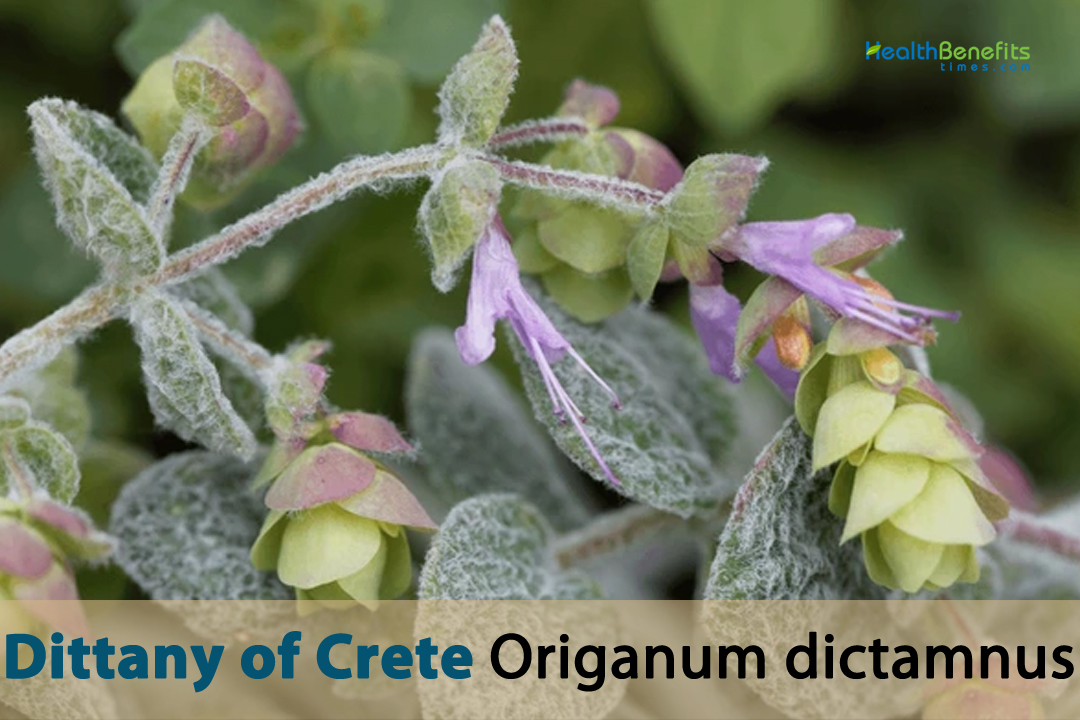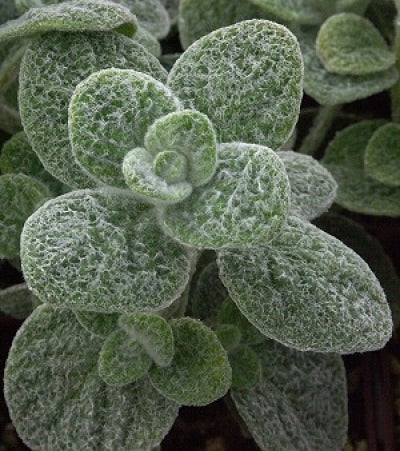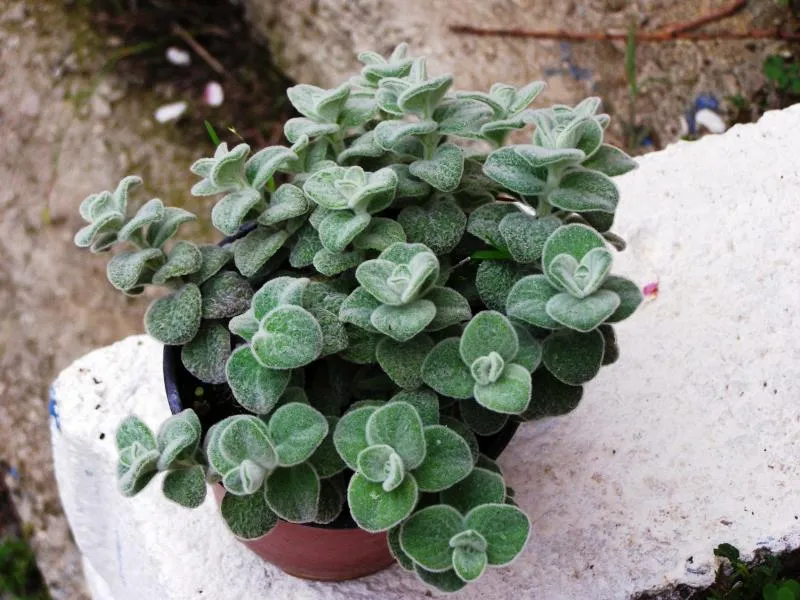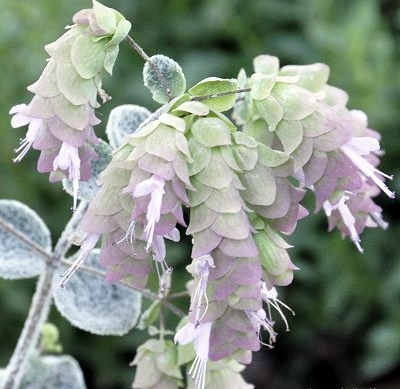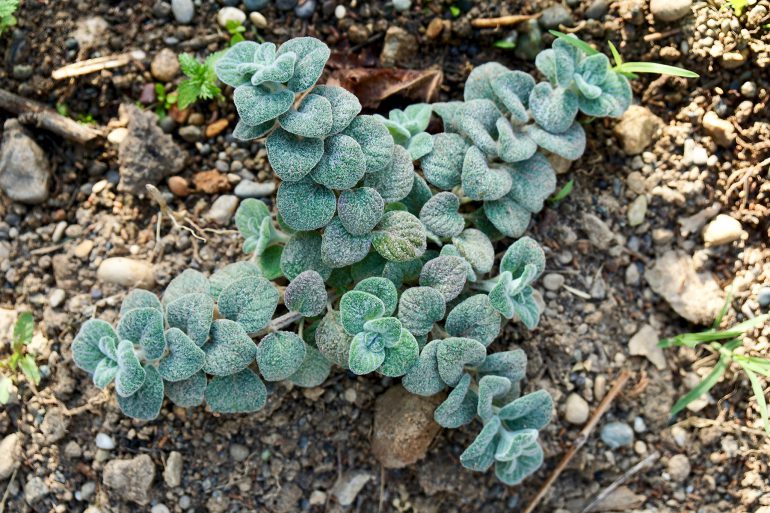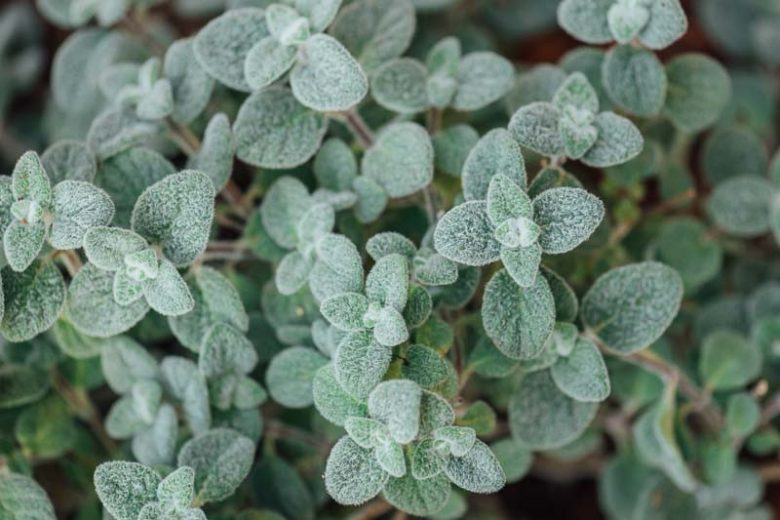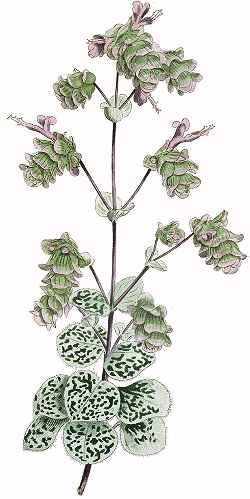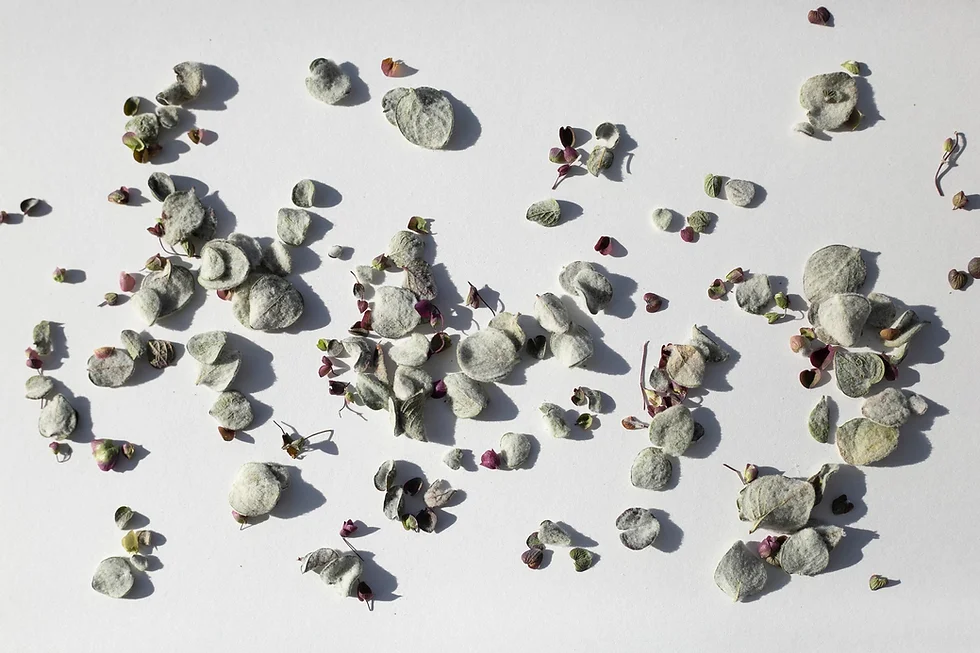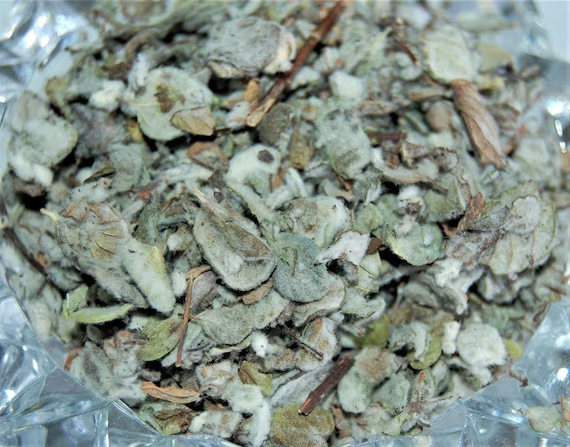| Dittany of Crete Quick Facts | |
|---|---|
| Name: | Dittany of Crete |
| Scientific Name: | Origanum dictamnus |
| Origin | Mediterranean region, specifically to the island of Crete in Greece |
| Colors | Brown or dark brown in color |
| Shapes | Nutlet that is typically oval or elliptical in shape, resembling a tiny seed |
| Taste | Sweet and slightly bitter flavors with herbal and earthy undertones |
| Major nutrients | • Vitamins • Minerals • Antioxidants • Essential oil |
| Health benefits | Kills Bad Bacteria, Regulates Blood Flow, Relieves Cough, Wound Healing, Good for Skin, Cardiovascular Health, Stress and Anxiety Relief, Treat Snake Bite, Aid for Menstrual Discomfort, Oral Health, Liver Health, Treats Urinary Tract Infections |
| Name | Dittany of Crete |
|---|---|
| Scientific Name | Origanum dictamnus |
| Native | Mediterranean region, specifically to the island of Crete in Greece |
| Common Names | Dittany, Cretan Wild Oregano, Love Plant, Dittany Herb, Burning Bush, Crete Rockrose, Hop Marjoram, Cretan Healing Herb, Cretan Hop Marjoram, Dittany of Crete, Dittany Thyme, Cretan Wild Marjoram, Cretan Pot Marjoram, Crete Dittany, Cretan Dittany, Diktamo, Diktamos, Dittany Mint |
| Name in Other Languages | Arabic: Diktāmun Krīt (ديكتامون كريت), Diktamni Kreet (ديكتامني كريت), fwdhinj tisi (فوذنج تيسي) Armenian: Susambar kretakan (Սուսամբար կրետական) Assamese: Krīṭ Ḍikṭāman (ক্ৰীট ডিক্টামান) Bengali: Krīṭēra ḍikṭāman (ক্রীটের ডিক্টামন), Kreeter Ditani (ক্রীটের ডিটানি) Bhojpuri: Kreeta ke Dittani (क्रीट के दित्तानी) Bulgarian: Kritski diktam (Критски диктам), krit·ski rigan (критски риган) Catalan: Dictam de Creta Chhattisgarhi: Kreeta ke Dittani (क्रीट के दिटानी) Chinese: Kèlǐtè bǎilǐxiāng (克里特百里香), Yán ài cǎo (巖愛草) Croatian: Kritski diptam Czech: Krétský dikťámen Danish: Kretensisk diktamn, Kretisk diktamn Dogri: Kreeta Di Dittani (ਕ੍ਰੀਟ ਦੀ ਡਿਟਾਨੀ) Dutch: Cretaanse Dittany, Kretische Oregano English: Cretan dittany, Hop marjoram, Wintersweet, Cretan oregano, Crete oregano, Dittany of Crete, dittany Estonian: Kreeta diktaam Finnish: Kreetan diktamni, Kreikkalainen Ditanny, Kreetanmeirami French: Dictame de Crète, Dictamne de Crète, Faux origan, Origan de Crète, Origan dictamne Garhwali: Kreeta ka Dittani (क्रीट का डिट्टानी) Garo: Krete Dittani German: Kretischer Dost, Diptam-Dost, Kretischer Diptam, Diptamdosten, Kretischer oregano, Diptamdost Greek: Díktamo tis Krítis (Δίκταμο της Κρήτης), Diktamo, Dictamos (Δίκταμος), Kritikí rígani (Κρητική ρίγανη), Díktamo (Δίκταμο) Gujarati: Krīṭ nuṁ Ḍikṭamen (ક્રીટ નું ડિક્ટમેન) Hebrew: Diktamon Kratim (דיקטמון כרתים), Diktamon Kriti (דיקטמון כרתי) Hindi: Kreṭa kā diktaman (क्रीट का दिक्तमन), Kreet ka Ditani (क्रीट का दिटानी) Hungarian: Krétai diptamnusz, Krétai diktám, Krétai szurokfű Icelandic: Krítardikta Italian: Dittamo di Creta, Dittamo cretico, Origano di Candia Japanese: Kureta no Dikutamu (クレタのディクタム), Kureta no Dikutamunusu (クレタのディクタムヌス) Kannada: Krīṭ ḍikṭaman (ಕ್ರೀಟ್ ಡಿಕ್ಟಮನ್) Kashmiri: Kreeta Di Dittani (کریٹ دی ڈٹنی) Khasi: Kreet Dittani Konkani: Kreeta Ditani (क्रीट डिटानी) Korean: Keureta Diktam (크레타 딕탐), Keureta Diktamuseu (크레타 딕타무스) Kumaoni: Kreeta ka Dittani (क्रीट का डिट्टानी) Latvian: Krētas dikts Lithuanian: Kritinis diktamas Malayalam: Krīṛṛiṇṭe Ḍikṭamaṇ (ക്രീറ്റിന്റെ ഡിക്ടമൻ) Maithili: Kreeta ke Ditani (क्रीट के डिटनी) Manipuri: Kreeter Ditani (ক্রীটের ডিটানি), Kreet Dittani Marathi: Krīṭ che Ḍikṭaman (क्रीट चे डिक्टमन) Malay: Dittany Crete Nepali: Krīṭako Ḍikṭaman (क्रीटको डिक्टमन), Kreeta ko Dittani (क्रीटको दिट्टनी) Norwegian: Kretisk diktamn Odia: Krīṭa Ḍikṭāmana (କ୍ରିଟ ଡିକ୍ଟାମନ୍) Oriya: Kreeta Dittani (କ୍ରିଟେ ଡିଟାନି) Persian: Dīktāman Krīt (دیکتامن کریت) Polish: Dikti Czyli Cretan Dittany Portuguese: Dictamno de Creta Punjabi: Krīṭ dā Ḍikṭamaiṇ (ਕ੍ਰੀਟ ਦਾ ਡਿਕਟਮੈਨ), Kreeta Di Dittani (ਕ੍ਰੀਟ ਦੀ ਦਿੱਟਨੀ) Rajasthani: Kreeta ki Dittani (क्रीट की डिट्टनी) Romanian: Dictamnul din Creta, Dicțamn de Creta Russian: Kritskaya diktamn (Критская диктамн), Diktamn kritskiy (Диктамн критский), Dušica kritskaâ (Душица критская) Sanskrit: Krittamari (कृत्तमारी) Santali: Kreet Dittani Serbian: Kritski diktam (Критски диктам) Sindhi: Kreet Jo Dittani (ڪريٽ جو ڊٽاني) Sinhala: Krīṭ Ḍiktaman (ක්රීට් ඩික්ටමන්) Slovak: Krétsky diptamén, Pamajorán Slovenian: Kretski diktam Spanish: Díctamo de Creta, oregano de Creta Swedish: Kretansk diktamn, Kretensisk diktamn, Kretansk Dittany, Kretadiptam Tamil: Kirēṭ ṭikṭamaṉ (கிரேட் டிக்டமன்) Telugu: Krīṭ ḍikṭaman (క్రీట్ డిక్టమన్) Thai: Dittani hạ̀ng kriīs (ดิททานี่แห่งกรีซ), Dittani of Crete (ดิตทานี ออฟ ครีต) Tripuri: Kreet Dittani Tulu: Kreeta Dittani (ಕ್ರೀಟ್ ಡಿಟ್ಟನಿ) Turkish: Girit Diktamosu, Girit dikta, Girit Isırganı, girit kekiği Ukrainian: Kryts’kyy dyktamn (Критський диктамн), Materynka kryt·sʹka (Материнка критська) Urdu: Krīṭ ka ḍikṭamīn (کریٹ کا ڈکٹمین) Vietnamese: Dittany của Crete |
| Plant Growth Habit | Small aromatic herbaceous perennial plant |
| Growing Climates | Found growing among rocks or in rocky crevices, rocky hillsides, slopes, and in mountainous regions |
| Soil | Prefers well-drained stony, or sandy soils. Avoid planting it in wet areas, as it dislikes soggy soil, which may lead to root rot and fungal diseases |
| Plant Size | Typically grows to a height of about 20 to 30 centimeters (8 to 12 inches) |
| Root | Develops a taproot as its primary root structure that grows vertically into the soil. It serves as the primary anchoring structure for the plant. From the taproot, numerous lateral roots extend horizontally and diagonally into the surrounding soil |
| Stem | Stems are upright to prostrate and arching. They are hairy, with opposite grey-green leaves at each node. |
| Bark | Does not have a significant woody stem or bark |
| Leaf | Entire, round to oval-shaped and deeply veined about 1 to 3 cm (0.4 to 1.2 inches) long and 0.5 to 1 cm (0.2 to 0.4 inches) wide. They are aromatic and very hairy, which gives them a velvety appearance and a silver color |
| Flowering season | May to June |
| Flower | Flower clusters hang in spiky formations, with small pink blossoms peeking through tightly overlapping bracts that look like hops. The flowers have two lips. The upper lip is notched, and the lower lip has 3 lobes |
| Fruit Shape & Size | Produces nutlet that is typically oval or elliptical in shape, resembling a tiny seed. They are small and measure just a few millimeters in length |
| Fruit Color | Brown or dark brown in color |
| Seed | Quite small, typically measuring around 1 to 2 millimeters in length. They are oval to elliptical in shape, with a slightly flattened profile |
| Flavor/Aroma | Herbal, spicy, and slightly sweet |
| Taste | Sweet and slightly bitter flavors with herbal and earthy undertones |
| Plant Parts Used | Leaves, flowers, essential oil, resin, roots |
| Propagation | By seeds, Stem Cuttings and division |
| Lifespan | For 10 to 20 years or more |
| Season | August to September |
| Varieties |
|
| Major Nutrition |
|
| Health Benefits |
|
| Available Forms |
|
Plant Description
Dittany of Crete, also known as Hop Marjoram, is a small, soft, fragrant annual herb that grows in a cushion shape and spreads out. In general, the plant gets to be about 20 to 30 centimeters (8 to 12 inches) tall. In hilly areas, the plant grows among rocks or in cracks in rocks on hillsides, slopes, and in mountainous areas. Rocks and dry places are good places for it to grow. It likes sunny spots, but you can also see it in shady spots. It likes sandy or stony soils that drain well. It doesn’t like soggy soil, which can cause root rot and fungal diseases, so don’t put it in wet places. This plant grows wild only in the mountains and valleys of the Greek island of Crete. It is good for you and smells nice. It is used to add taste to food and as medicine, and it also looks nice in gardens as an ornamental plant.
In Mediterranean cooking, Dittany of Crete is used as a plant. People often add its leaves to salads, stews, and roasted foods to give them a unique and fragrant taste. Dittany of Crete has been used for many medical reasons in traditional herbal medicine. It’s thought to have qualities that can help with skin conditions, breathing problems, and digestive problems. It has also been used to treat cuts and bug bites naturally because it is thought to help them heal. In some areas, the Dittany of Crete has lost habitat and been overfished, which has raised conservation worries. People have worked hard to keep this important herb safe and grow it. The IUCN Red List of Threatened Plant Species 1997 says that the dittany is fragile.
Appropriate growing environment for Dittany of Crete
Dittany of Crete is a Mediterranean herb that thrives in specific environmental conditions. Here are the key factors to consider for creating an appropriate growing environment for Dittany of Crete:
- Climate: Dittany of Crete comes from the Mediterranean and likes summers that are hot and dry and winters that are mild and wet. The Mediterranean temperature makes it grow well. The summers are warm to hot, and the winters are mild and rainy. It does well in USDA hardiness zones 7 through 9, where it doesn’t get too cold in the winter.
- Sunlight: For Dittany of Crete to grow well, it needs a lot of sunshine. You should put it somewhere where it will get full sun for most of the day. This vegetable does best with at least 6 to 8 hours of direct sunlight a day.
- Soil: Dittany of Crete grows best in sandy or rocky soil that drains well. It grows best in soil that is slightly alkaline to neutral (around 6.0 to 7.5 pH). Root rot can happen if roots get too wet, so it’s important that the soil drains well.
- Watering: Once it’s established, Dittany of Crete can handle dryness, but it still needs to be watered often during its growing season, which is usually spring and summer. The plant doesn’t like to sit in wet soil, so let it dry out a bit between watering.
- Pruning: Regularly prune the plant to make it grow bushier and to get the fragrant flowers and leaves. In addition, this keeps the plant from getting too tall.
- Protection from extreme cold: If you live somewhere that gets cold in the winter, you might want to protect Dittany of Crete during that time. Putting mulch around the plant’s base can help keep the roots warm.
- Container growing: You can grow Dittany of Crete in a pot and bring it inside during the coldest months if you live in a place with hard winters. Make sure the jar can drain well.
- Fertilization: Dittany of Crete doesn’t need a lot of fertilizer. In the spring, you can help plants grow by giving them a balanced, slow-release fertilizer.
Roots
Dittany of Crete usually grows a taproot as its main root structure. The main root that grows straight down into the ground is called the taproot. It is the main support that holds the plant in place. From the taproot, many lateral roots grow into the dirt in both horizontal and diagonal directions. The plant can get water and nutrients from a bigger area of soil more easily with the help of these side roots. On the outside of the root system are small structures that look like hairs. These are called root hairs. Hairs on the roots are what take water and minerals from the soil and hold them in. They make a lot more surface area available for taking in nutrients.
Different roots go deeper into the ground at different depths, but most of them only go a few inches to a foot deep. The plant does well in rocky, well-drained soils, which are typical in its native Mediterranean habitat, because its roots are not very deep. Dittany of Crete can sometimes make rhizomes, which are horizontal roots that grow from the ground. Some plants can make new shoots and plants from rhizomes, which helps the plant spread and grow.
Stem
Dittany of Crete is an herbaceous plant, which means that its stem doesn’t have any hard tissue and stays soft and bendy all the way through its life. The stem is green and doesn’t usually turn into a base or branches made of wood. Many plants in the Lamiaceae (mint) family have stems that are square or slightly angled. Dittany of Crete is no different. This is something that all plants in this family have in common. It feels a little fuzzy or smooth because the stem is covered in fine hairs, which are called pubescence. This pubescence might protect against animals and keep water from escaping. The plant usually grows in a bushy or mounding shape, with several roots coming out of the middle.
Bark
Dittany of Crete is mostly known for its fragrant flowers and leaves. Unlike trees and shrubs, it doesn’t have a strong woody stem or bark. Instead, it is a plant that grows from seeds and has soft, green stems. Because of this, its bark doesn’t have the usual structure of woody plants like trees and shrubs. Its roots, on the other hand, have a fairly uniform texture and look.
Leaves
The leaves on a Dittany of Crete stem are arranged in a design that goes against the stem. In other words, at each leaf node along the stem, there are two leaves that are right next to each other. The leaves have a pointy tip and a curved base. They are either lance-shaped or ovate-shaped. Their shape, which is long and slightly narrow, helps you tell them apart from other plant types. The leaves are pretty small, reaching only 0.4 to 3 centimeters (1.2 to 1 inch) across. The leaves are about 0.5 to 1 centimeter (0.2 to 0.4 inches) wide. The leaves range in color from gray to green. The leaves may look a little white because they have fine hairs covering them, making them feel fuzzy or velvety. The leaves have small hairs on them, which is called pubescence and makes them feel a little fuzzy. These hairs might help keep the plant from losing water through transpiration and protect it from predators.
The ends of leaves are smooth and not toothed or serrated, which is what is meant by “whole margins.” There is a big vein in the middle of the leaf that is called the midrib. Smaller veins run off of it and make a network all over the leaf. Water, nutrients, and sugars are moved around inside the leaf by these lines. There are small petioles that connect the leaves to the stem. The stalk that joins the leaf blade to the stem is called the petiole. There may be a small curve or roundness to the tip of the leaf. The petiole, which is at the base of the leaf, is narrower than the base of the leaf and connects it to the stem.
Flower
Dittany of Crete has flowers that grow at the ends of spikes or cymes. The flower grows from the upper leaf axils, which are the points where the leaf and stem meet. A lot of the time, these spikes are tight and full of flowers. Each flower is only about 5 to 10 millimeters (0.2 to 0.4 inches) across. People think of them as small and fragile-looking. Each flower is tube-shaped and long and narrow, like a small trumpet or bell. This tube-like shape is common in many plants in the mint family (Lamiaceae), which Dittany of Crete is in. The flowers are mostly pink to purple, but they can be different shades of pink, mauve, or lavender. The exact color can be a little different depending on the plant and its surroundings.
The flower’s tubular structure is made up of five petals that are joined together. These petals often have small fringes around the edges, which makes the flower look pretty and delicate. Inside the tube-shaped corolla, there are usually four stamens that stick out past the tube. Stamens are male reproductive parts. For reproduction to happen, the stamens carry the pollen. The pistil, which is the female reproductive center, is in the middle of the flower. The flower has one style with a stigma on top that can accept pollen. The pistil sticks out past the corolla tube, which lets pollen get to the flower. There is a calyx around the base of the flower made up of five sepals that cover the flower bud as it grows. Often, the petals are purple or green, the same color as the stem and leaves.
Along with the leaves, flowers also have essential oils that make them smell good. The flowers smell sweet and herbal, which adds to the beauty of the plant as a whole. Bees, butterflies, and other animals, drawn to the nectar and scent of flowers, spread pollen from one flower to another. Dittany of Crete flowers between late spring and early summer, but this depends on where it grows and the situations it is in. From year to year, the blooming time can be a little different.
Fruits
Schizocarpic fruits are made by Dittany of Crete. This means that each flower makes four separate nutlets or seeds inside a single growing structure. The form of each nutlet is usually oval or elliptical, like a small seed. They are very small, only a few millimeters long. The nutlets are usually brown or dark brown when they are fully grown. They are easy to tell apart from the green parts of the plant because of their color. It looks like the nutlets have a glossy finish on their smooth, shiny surface. To the nutlets are connected a central stalk or axis that is part of the structure of the fruit. The four nutlets are held together by this center axis until they are ready to separate.
Seeds
A seed is only about 1 to 2 millimeters long, which is pretty small. They have a slightly flattened shape and are oval to elliptical in form. Most seeds are brown to dark brown, which helps them mix in with the dried flowers and leaves of the plant. The outside of seeds is smooth and hard. They often look like they are shiny. Each seed has a seed coat, or top layer, that protects it. This seed coat is pretty thin, but it’s strong and protects the fetal plant inside. There is a plant egg inside the seed coat. If conditions are right, this embryo will grow into a new plant. This part of the seed has all the genetic information that the plant needs to grow.
Varieties of Dittany of Crete
Dittany of Crete is a fragrant herb that grows primarily on the island of Crete in Greece. It has been used for centuries for its medicinal and aromatic properties. There are several varieties and subspecies of Dittany of Crete, each with its own unique characteristics and uses. Here are some of the main varieties:
- Origanum dictamnus subsp. albidum: The normal Origanum dictamnus looks a lot like this subspecies, but the flowers are white instead of pink or purple. Besides cooking, it is also used in traditional healing.
- Origanum dictamnus subsp. drenowskyi: This subspecies lives on the Greek island of Karpathos and is sometimes thought of as a different species, which is called “Dictamnus drenowskyi.” It has pink flowers and small, round leaves that make it stand out.
- Origanum dictamnus subsp. inermis: This type of plant lives on the island of Rhodes. It has small, lance-shaped leaves and pink flowers. It is used the same way as other types of Dittany of Crete.
- Origanum dictamnus subsp. orianiticum: The high amount of essential oil in this subspecies makes it valuable. It is native to the Oria area of Crete. Quite often, it is used to make perfumes and essential oils.
Health benefits of Dittany of Crete
Dittany of Crete has a long history of traditional use and is believed to offer various health benefits, although scientific research on its effects is ongoing. Here are some of the potential health benefits of Dittany of Crete in detail:
1. Digestive Health
Dittany of Crete has been used for a long time to help digestion. It might help ease the pain and discomfort of indigestion, gas, and bloating. The essential oils in the herb can help the body make more stomach enzymes, which can make digestion better overall.
2. Anti-Inflammatory Properties
People think that the plant can help reduce inflammation. Flavonoids and carvacrol are some of the chemicals that are found in it that may help reduce inflammation in the body. For people with arthritis and inflammatory bowel problems, this may help.
3. Kills Bad Bacteria
One study in the lab found that Cretan Dittany in the form of oil may help stop the growth of harmful germs. In fact, germs like Salmonella and E. coli are part of this study. Don’t forget that these two germs cause food poisoning.
4. Antioxidant Activity
Polyphenols and flavonoids are just two of the many vitamins that can be found in Dittany of Crete. Free radicals are harmful molecules that can cause chronic diseases and early aging. These substances help get rid of them.
5. Immune System Support
Both the herb’s antioxidant qualities and its possible antimicrobial effects may help the immune system. It might help the body fight off sickness and diseases.
6. Regulates Blood Flow
It can help control the flow of blood in the pelvic area because it is an emmenagogue. In traditional medicine, this plant has been used to help women who are having trouble or don’t have their periods.
7. Respiratory Health
Dittany of Crete has been used for a long time in traditional medicine to help with coughs, colds, and asthma. The vital oils in the herb may help soothe the lungs and make symptoms better.
8. Relieves Cough
If you have a cough from a cold, drinking a cup of tea made with Cretan Dittany might help. You could add honey or lemon to your tea to make it taste sweet. However, if your cough doesn’t go away or lasts more than a week, you should see a doctor to avoid a more serious problem.
9. Wound Healing
The essential oils of Dittany of Crete are antibacterial, which means they can help wounds heal. It might help clean cuts, lower the risk of infection, and help them heal faster
10. Good for the Skin
Cretan Dittany is also used in the beauty business. In fact, it’s used to feed and hydrate skin that’s been parched. A lot of people want to see the natural beauty that the Cretan dittany can offer. That’s not all; it can also be used to get rid of wrinkles. So, this plant might help you keep your face healthy.
11. Cardiovascular Health
Dittany of Crete has antioxidants that may help heart health by lowering the risk of oxidative stress and making blood vessels work better. It might make you less likely to get heart problems.
12. Stress and Anxiety Relief
The essential oils from Dittany of Crete have a nice and relaxing smell. It is sometimes used in aromatherapy to help people feel less stressed and anxious and more relaxed.
13. Antibacterial and Antifungal Properties
Compounds in Dittany of Crete have antibiotic and antifungal properties. It might help fight different pathogens and illnesses.
14. Treat Snake Bite
In the past, juice from the Cretan Dittany was mixed with wine. This might help heal a snake bite. However, there is no study that shows that this plant can heal snakebites, but the dittany of Crete may help with skin problems and inflammation. Remember to see a doctor right away if something goes wrong.
15. Anti-Cancer Potential
Some research studies show that some compounds in Dittany of Crete may help fight cancer, but more studies are needed to be sure.
16. Anti-Rheumatic Properties
Dittany of Crete has been used for a long time to ease the pain of rheumatism and the signs of diseases like rheumatoid arthritis. It may help people with joint pain and stiffness because it reduces inflammation and eases pain.
17. Aid for Menstrual Discomfort
Because it relaxes muscles, the plant can be especially helpful for women who are having menstrual cramps. When used in small amounts, Dittany of Crete may help ease the pain and discomfort of menstruation.
18. Oral Health
Dittany of Crete is in some mouthwashes and other oral care items because it may kill germs and reduce inflammation. It might help keep your teeth healthy by lowering the amount of bacteria and swelling in your mouth.
19. Aromatherapy for Sleep
In aromatherapy, the relaxing scent of Dittany of Crete is sometimes used to help people sleep better and stop having trouble staying asleep. It’s possible that breathing in the smell before bed will help you relax and sleep better.
20. Liver Health
The vegetable has been used for a long time to help the liver work better. It may help the body get rid of toxins and protect the liver from damage caused by free radicals because it is an antioxidant.
21. Potential Anti-Allergic Effects
Some early research shows that chemicals in Dittany of Crete might help people who are allergic to certain things. It could help ease allergic responses and symptoms.
22. Anti-Aging Potential
Free radicals and oxidative stress can make skin age faster than it should. The antioxidants in Dittany of Crete may help protect the skin from this. Keeping your face looking young may be helped by it.
23. Treats Urinary Tract Infections
The herb may help flush out toxins and bacteria from the urinary system because it is a diuretic. This could help treat urinary tract infections (UTIs).
Culinary Uses of Dittany of Crete
Dittany of Crete is used to add flavor and aroma to various dishes. Here are some culinary uses of Dittany of Crete:
- Seasoning: Dittany of Crete, both fresh and dried, is often used as a cooking spice. The leaves taste strong and fragrant, with hints of oregano and thyme. It can be used to season a lot of different foods, like vegetables, meat, chicken, and fish.
- Herb Blends: Spice and herb mixes often have it in them. For example, Herbes de Provence is a famous herb blend used in French and Mediterranean cooking. You can add these mixes to roasted or grilled foods to make them taste better.
- Soups and Stews: Dittany of Crete can be added to soups and stews to make them taste better. It goes well with tomato-based soups, bean soups, and meat stews, giving them a pleasant smell and taste.
- Salad Dressings: You can add a unique Mediterranean taste to salad dressings by using the herb’s leaves, whether they are fresh or dried. It goes well with lemon juice, vinegar, and olive oil in salad and pasta salad sauces.
- Marinades: You can put Dittany of Crete in marinades for meat, chicken, and seafood. It gives food a great taste and makes the meat more tender thanks to its aromatic properties.
- Roasted and Grilled Dishes: When you roast or grill meats, seafood, or veggies, sprinkle dried Dittany of Crete leaves on top. It gives the taste a layer of rich, herbal flavor that makes it better overall.
- Bread and Baked Goods: Sometimes, Dittany of Crete is added to bread, pizza dough, and savory desserts to make them taste better. It makes baked items taste different.
- Omelets and Frittatas: For a Mediterranean twist on breakfast or brunch foods, add fresh or dried Dittany of Crete to omelets, scrambled eggs, or frittatas.
- Infused Olive Oil: Adding dried Dittany of Crete leaves to extra virgin olive oil will give it a flavor. You can dip bread in the oil, drizzle it over veggies, or use it as a base for salad dressings.
- Herbal Tea: Even though it’s not really a cooking use, Dittany of Crete can also be used to make plant tea. By letting its leaves steep in hot water, you can make a fragrant, peaceful drink that might be good for you.
- Pasta Dishes: If you want to season spaghetti, linguine, or penne, you can use Dittany of Crete. For a Mediterranean-style taste, just sprinkle it over cooked pasta with garlic, olive oil, and Parmesan cheese.
- Herb Butter: To make a tasty herb butter, mix melted butter with finely chopped fresh Dittany of Crete leaves. You can put this herb butter on top of grilled steaks, seafood, or veggies that have been roasted.
- Pizza Topping: Sprinkle dried Dittany of Crete on pizza, whether you make it yourself or buy it. It goes well with tomato sauce, cheese, and different toppings, making the pizza taste better all around.
- Casserole Seasoning: You can season baked goods and casseroles like lasagna or moussaka with Dittany of Crete. The smells that come from it can make layered and baked foods taste better.
- Pickling: The leaves of Dittany of Crete can be used in pickling recipes, especially for veggies like peppers and cucumbers that are being pickled. The pickles get a unique Mediterranean taste from it.
- Herbal Rubs: Mix Dittany of Crete with other spices and herbs, such as garlic, rosemary, and thyme, to make herb rubs. Before you grill or roast meat or fish, you can season it with these rubs.
- Mediterranean Dips: Add Dittany of Crete to dips and spreads that are based on the Mediterranean. To make tasty dips for veggies or pita bread, mix it with things like yogurt, tahini, garlic, and lemon juice.
- Sauces and Gravies: Add the fragrant taste of Dittany of Crete to soups and gravies. It can be added to tomato sauces, white wine sauces, and gravies that are given with chicken or meat.
- Homemade Seasoned Salt: To make your own seasoned salt, mix dried Dittany of Crete with sea salt. This can be added to baked potatoes, grilled chicken, popcorn, or other foods to finish them off.
- Herbal Marinades for Vegetables: You can make marinades for grilled or roasted veggies by mixing Dittany of Crete with olive oil, balsamic vinegar, and other herbs. It can make veggies like bell peppers, zucchini, and eggplant taste better.
- Herbal Infusions for Oils and Vinegars: Dittany of Crete can be added to vinegar or olive oil to make flavored vinegars or oils that can be used for salad sauces, marinades, or dipping.
- Cocktail Garnish: Fresh Dittany of Crete leaves make a unique garnish for cocktails. They give drinks like gin and tonics and mojitos a refreshing green smell.
- Herbal Focaccia: Add Dittany of Crete to the dough for making focaccia bread at home. It gives the bread a great taste and goes well with sea salt and olive oil.
Different uses of Dittany of Crete
Dittany of Crete has a range of uses beyond its culinary and potential health benefits. Here are some different uses of Dittany of Crete:
- Herbal Medicine: Herbal medicine has used Dittany of Crete for a very long time. People think it has many health benefits, such as reducing inflammation, protecting cells from damage, and helping the digestive system. Herbal drinks, tinctures, and poultices made from it have been used to treat health problems.
- Aromatherapy: Aromatherapy makes use of the essential oil that is taken from Dittany of Crete. People say that its pleasant smell can help them relax and cool down. The smell can help you relax and feel good about yourself.
- Ornamental Plant: Dittany of Crete is grown in parks and landscapes as an ornamental plant. It looks nice in parks because it has pretty, fragrant leaves and bright pink or purple flowers.
- Natural Insect Repellent: Some insects are thought to stay away from Dittany of Crete because of its smell. It keeps bugs like mosquitoes and flies away for some people who put it in their gardens or near windows.
- Flavoring in Beverages: Dittany of Crete can be used to add taste to alcoholic drinks as well as herbal teas. It is sometimes added to liqueurs, infusions, and drinks to give them an herbal taste.
- Traditional Rituals: Some cultures have used Dittany of Crete in ceremonies and practices that go back a long time. As an incense or as part of practices for healing, purification, or protection, it can be burned.
- Cosmetics and Personal Care: Extracts and essential oils from Dittany of Crete are sometimes used in beauty and personal care items. Because they smell nice and might help soothe the skin, they are used in perfumes, hair care products, and skin care products.
- Herb Gardening: Dittany of Crete is often grown in herb fields because it looks nice and can be used in cooking. Patios and decks are good places to grow it in pots.
- Traditional Crafts: Dittany of Crete has been used in ancient crafts in some places. Its dried flowers and leaves can be used to make wreaths, flower arrangements, or projects that are meant to look nice.
- Educational and Research: The plants that grow in Dittany of Crete are also studied and looked into for their possible medicinal qualities. It is used to teach about plants and do study on plant taxonomy and phytochemistry.
- Herbal Bath: You can add Dittany of Crete leaves or essential oil to your bathwater to make it more relaxing and pleasant to smell. It might help relax you and ease your muscles.
- Potpourri: Your home can smell nice with dried Dittany of Crete flowers and leaves. When put in pretty bowls or sachets, their nice scent can make rooms smell better.
- Natural Air Freshener: You can use dried Dittany of Crete to make the air smell better. To give things a nice smell, just put a sachet of dried leaves in a closet, box, or room.
- Herbal Infusions: You can use Dittany of Crete to make plant infusions in hot or cold water, as well as tea. You can drink these liquids on their own or use them as a base for cocktails and mock tails.
- Sachets for Linens: Dry Dittany of Crete leaves should be put in fabric bags and hidden in linen rooms or drawers. They can help clothes and blankets smell clean and herbal.
- Herbal Honey: To make herbal honey, add Dittany of Crete leaves to honey. If you want to add a unique herbal twist to your sweets, you can drizzle this honey over them or add it to herbal teas.
- Herbal Candles: For a natural and fragrant touch, add dried Dittany of Crete to candles you make yourself. During meditation or rest, the candles can be used to make the room feel calm.
- Scented Oils: Essential oil and leaves from Dittany of Crete can be mixed to make massage or aromatherapy oils with a pleasant smell. You can use the essential oil for rubs after diluting it with a carrier oil.
- Herbal Incense: You can burn dried Dittany of Crete leaves as incense sticks or smudge them as part of spiritual or relaxing practices. The smell of the smoke can make the room feel calm.
- Herbal Poultices: In traditional herbal treatment, Dittany of Crete leaf poultices were put on skin irritations, small wounds, and bug bites to make them feel better.
- Herbal Vinegar: Adding Dittany of Crete leaves to vinegar will make plant vinegar that tastes great. You can use this vinegar that has been incorporated in salad dressings or marinades.
- Natural Pest Control: Spread Dittany of Crete leaves around plants in your yard or around places to sit outside to keep bugs like ants and mosquitoes away.
- Crafts and Decorations: You can use dried Dittany of Crete flowers and leaves in arts and crafts projects, like making plant wreaths, flower arrangements, or decorations for special events.
- Herbal Smoking Blends: In some old ways of doing things, Dittany of Crete has been mixed with other herbs to smoke. Being careful is important, though, and you should know that smoking can be bad for your health.
Side effects of Dittany of Crete
Dittany of Crete is generally considered safe when used in moderation for culinary purposes and in accordance with established culinary practices. However, when used in larger quantities or for medicinal purposes, there can be potential side effects and considerations to be aware of:
- Allergic Reactions: There are some people who may be sensitive to or allergic to Dittany of Crete. If they are exposed to the plant, they may get rashes, itching, or breathing problems.
- Gastrointestinal Distress: If you take too much Dittany of Crete, it may irritate your digestive system and cause symptoms like nausea, vomiting, diarrhea, or stomach cramps.
- Skin Sensitivity: Some people can get dermatitis or skin sensitivity when they put Dittany of Crete essential oil on their skin without diluting it first. When applying essential oils to the skin, they should always be diluted with a carrier oil first.
- Photosensitivity: Some people may be more sensitive to sunlight (photosensitivity) after using skin care items with Dittany of Crete essential oil in them. This might cause sunburn or other skin problems if you get them in the sun.
- Interaction with Medications: Before using Dittany of Crete for medical reasons, you should talk to a doctor if you are taking any medicines, especially blood thinners or medicines that change your blood sugar levels. There is a chance that these medicines will not work well together or at all.
- Pregnancy and Breastfeeding: Women who are pregnant or nursing should be careful when using Dittany of Crete, especially when it comes in concentrated forms like essential oils. It’s best to talk to a doctor or nurse before using.
- Children and Infants: When around babies and young children, Dittany of Crete essential oil should be used with care. Always dilute it properly and never eat or drink it.
- Internal Use: Even though Dittany of Crete is used in cooking, it is best not to take too much of it or use strong extracts in large amounts. If you eat too much, it can make your stomach hurt.
- Quality and Purity: Make sure you only use real Dittany of Crete goods from trustworthy sellers, especially if you are using it for medical or therapeutic reasons. If a product is tampered with or of low quality, it may not work as expected.
References:
https://gd.eppo.int/taxon/ORIDI
https://pfaf.org/user/Plant.aspx?LatinName=Origanum+dictamnus
https://en.wikipedia.org/wiki/Origanum_dictamnus
https://www.missouribotanicalgarden.org/PlantFinder/PlantFinderDetails.aspx?taxonid=281581


